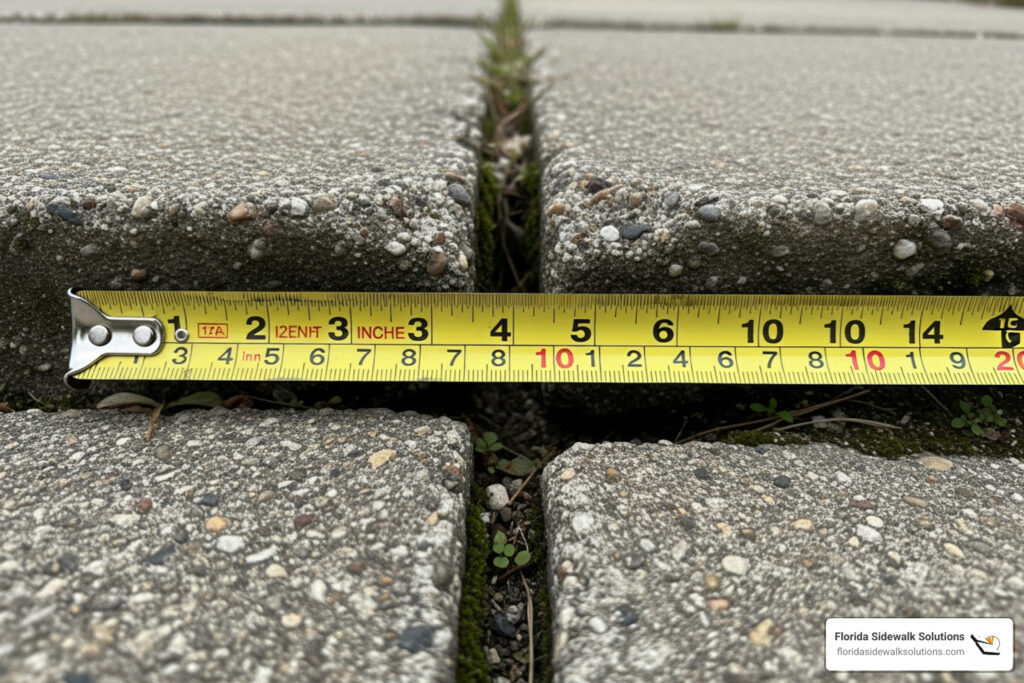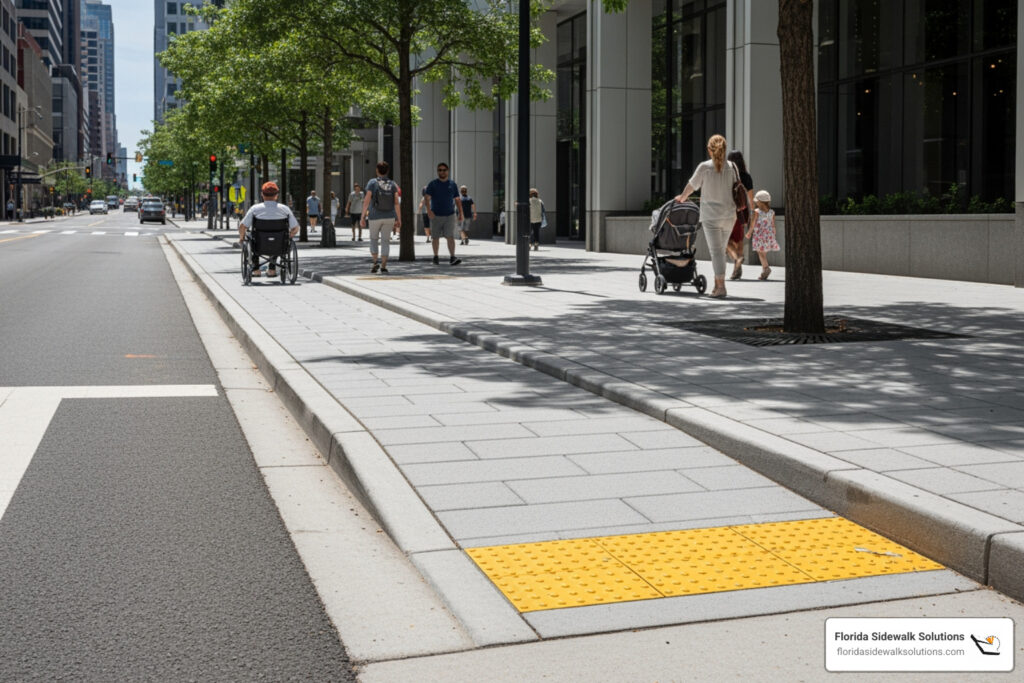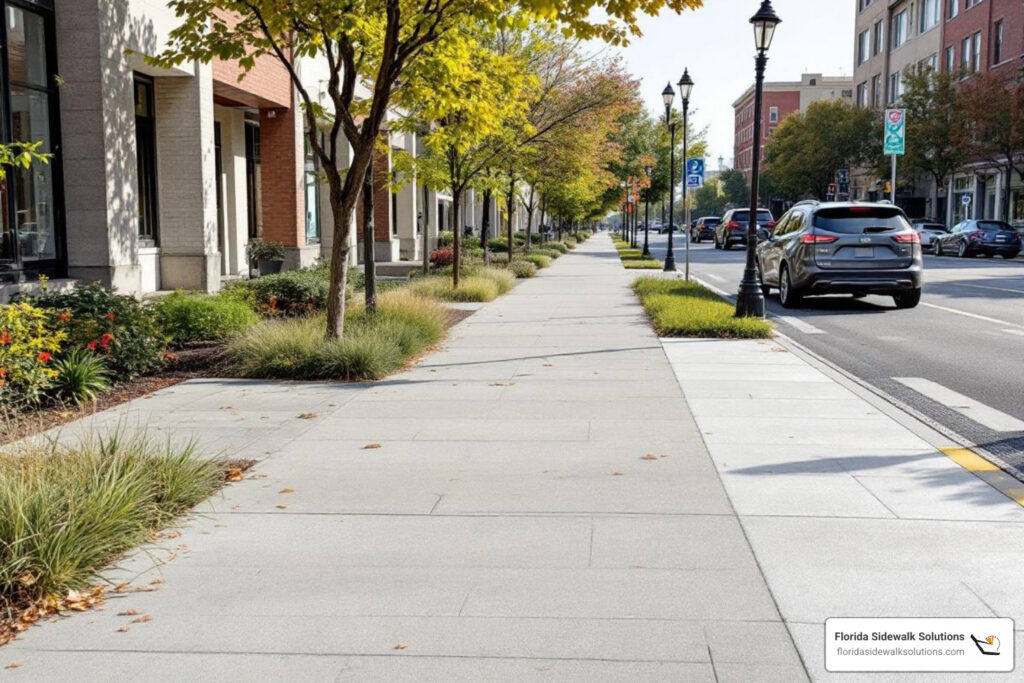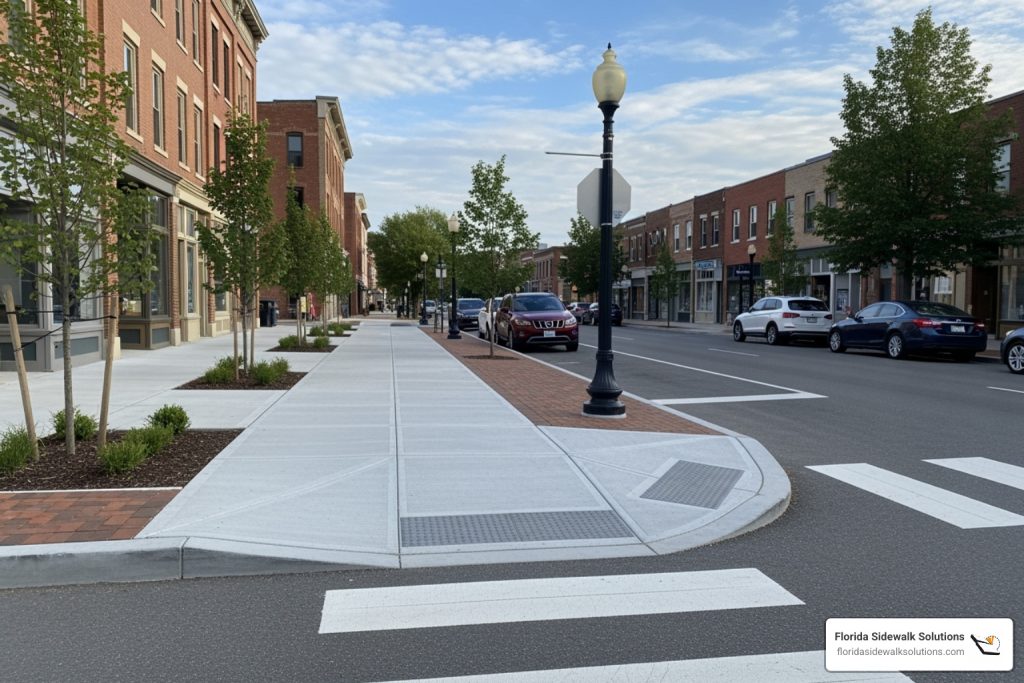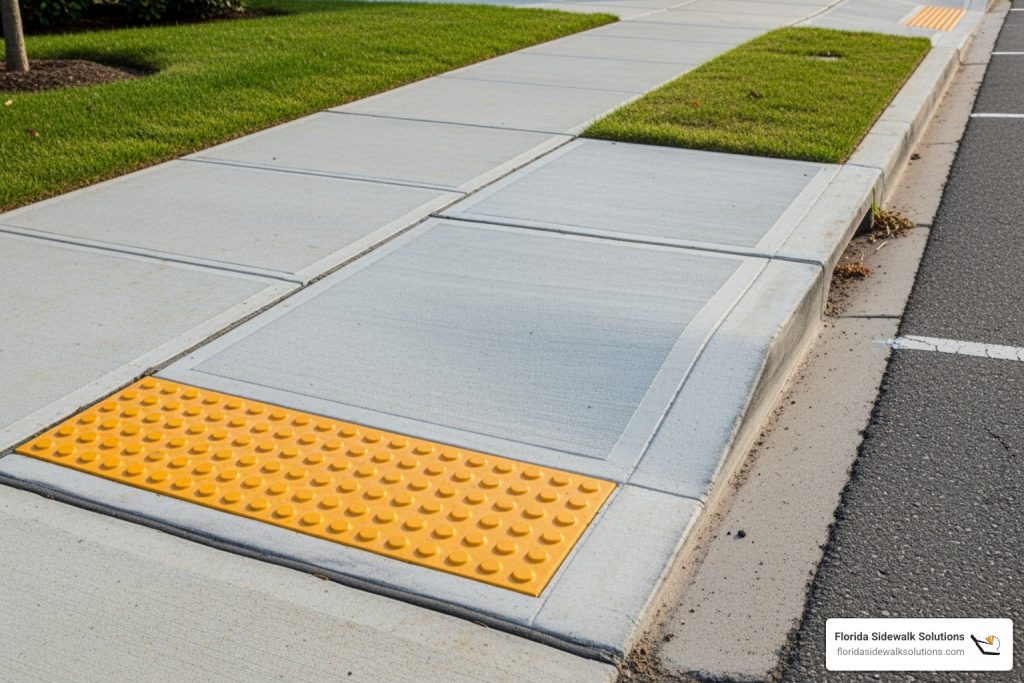Creating Safe and Accessible Pathways for All
The American with Disabilities Act (ADA) sidewalk accessibility guidelines establish the minimum requirements that ensure public walkways are accessible to people with disabilities. If you’re a municipal maintenance manager looking for quick facts about ADA sidewalk compliance, here are the key requirements:
| ADA Sidewalk Requirement | Specification |
|---|---|
| Minimum sidewalk width | 36 inches (3 feet) |
| Cross slope maximum | 1:48 (2%) |
| Running slope maximum | 1:20 (5%) |
| Trip hazard threshold | Any vertical change 64; 1/4 inch |
| Passing space requirements | 60 60 inches every 200 feet if width < 60 inches |
| Surface requirements | Firm, stable, and slip-resistant |
| Curb ramp maximum slope | 1:12 (8.33%) |
In order to meet the needs of all sidewalk users, municipal managers must understand the wide range of abilities within their communities. The Americans with Disabilities Act was designed to ensure that people with disabilities have equal access to public facilities2including the sidewalks that connect our communities.
When a person using a wheelchair encounters a sidewalk with excessive cross slopes, they may struggle to maintain a straight path. When someone with vision impairments approaches a street crossing without detectable warnings, they face potential danger. And when anyone2disabled or not2encounters a sidewalk trip hazard exceeding 1/4 inch, they risk injury from falling.
As the Federal Highway Administration notes, “Sidewalks should be designed to serve a full spectrum of users2from children to wheelchair users2rather than targeting a single user type.”
For municipal maintenance managers, addressing sidewalk compliance isn’t just about avoiding lawsuits (though that’s important too). It’s about creating inclusive communities where everyone can travel safely and independently.
The good news? Modern solutions like Florida Sidewalk Solutions’ precision cutting method can repair trip hazards and bring sidewalks into ADA compliance without the expense and disruption of complete sidewalk replacement.
American with Disabilities Act Accessibility Guidelines Sidewalks: The Basics
The American with Disabilities Act (ADA) sidewalk accessibility guidelines aren’t just complex regulations2they’re the foundation for creating communities where everyone can move freely and independently. Think of these guidelines as a promise: that our public spaces will welcome all people, regardless of their abilities.
When we talk about the ADA, we’re looking at a comprehensive civil rights law with different sections. Title II applies directly to state and local governments, while Title III covers public accommodations and commercial facilities. For sidewalk management, Title II is your primary focus, as it mandates accessibility for all newly constructed or altered government facilities2including the sidewalks connecting our communities.
“The Americans with Disabilities Act requires that new and altered facilities be accessible,” explains the U.S. Access Board, the agency responsible for developing and maintaining these guidelines.
Most accessibility requirements today follow the Department of Justice’s 2010 ADA Standards for Accessible Design. However, when working specifically with sidewalks and other public rights-of-way, many professionals also reference the Public Right-of-Way Accessibility Guidelines (PROWAG). While PROWAG hasn’t been officially adopted as federal standards yet, it represents the industry’s best practices and offers valuable guidance for creating truly accessible pathways.
Why ADA Applies to Every Sidewalk
Sidewalks aren’t just concrete paths2they’re lifelines connecting people to essential services, employment, education, and social opportunities. When a sidewalk isn’t accessible, it doesn’t just inconvenience someone with a disability2it can completely isolate them from their community.
The numbers tell a compelling story: over 61 million Americans live with some form of disability. Approximately 3.6 million people rely on wheelchairs for mobility, and about 12 million Americans have vision impairments. For these millions of people, an inaccessible sidewalk with trip hazards or excessive slopes isn’t merely an inconvenience2it can be a complete barrier to independent living.
As the Federal Highway Administration wisely notes, “In order to meet the needs of all sidewalk users, designers must have a clear understanding of the wide range of abilities that occur within the population.”
When we design and maintain sidewalks with accessibility in mind, we’re not just complying with laws2we’re building communities where everyone can participate fully.
Key Legal Definitions in ADA Sidewalk Accessibility Guidelines
Understanding the language of accessibility is crucial for anyone responsible for sidewalk maintenance:
Accessible Route refers to a continuous, unobstructed path connecting all accessible elements within a site. For sidewalks, this means creating pathways that meet all ADA requirements for width, slope, and surface conditions2allowing everyone to travel safely from point A to point B.
Pedestrian Access Route (PAR) is the PROWAG term describing the portion of a sidewalk or crossing that must comply with accessibility provisions. Think of it as the “accessible zone” within the broader pedestrian environment.
Curb Ramp creates the critical transition between sidewalk and street level, typically at intersections and crosswalks. These sloped surfaces enable wheelchair users to steer changes in elevation that would otherwise be impassable.
Detectable Warning surfaces feature those distinctive truncated domes you’ve likely noticed at crosswalks. These standardized tactile indicators warn people with vision impairments when they’re approaching vehicular areas2essentially serving as tactile “stop signs.”
Trip Hazard has a very specific definition under the ADA: any vertical change of 1/4 inch or more at any joint or crack in a sidewalk. These seemingly minor elevation changes can cause major problems for wheelchair users and create dangerous tripping conditions for everyone.
Florida Sidewalk Solutions specializes in addressing these trip hazards with precision cutting technology that brings sidewalks into compliance without the expense and disruption of complete replacement. Their patented method offers municipalities a cost-effective way to fulfill their ADA obligations while creating safer pathways for all community members.
Dimensional & Surface Requirements You Can’t Ignore
When it comes to ADA sidewalk accessibility guidelines, precise measurements matter. Even small deviations from standards can create significant barriers for people with disabilities.

Width & Passing Spaces (Every 200 ft)
Have you ever tried to steer a narrow hallway with shopping bags? Now imagine doing that in a wheelchair with no way to turn around! That’s why the ADA requires sidewalks to have a minimum clear width of 36 inches (3 feet). This width accommodates someone using a wheelchair, but doesn’t allow for passing or turning.
For this reason, if a sidewalk is less than 60 inches wide, you must provide passing spaces at least 6060 inches every 200 feet. I like to explain it to clients this way: “Imagine being on a one-way street with no exits for 200 feet2that’s what a narrow sidewalk feels like to a wheelchair user without adequate passing spaces.”
For shared-use paths where both pedestrians and cyclists travel, wider minimums typically apply2usually 8 to 10 feet, depending on expected traffic. These wider pathways create safer environments for everyone using the space.
Surface Texture & Trip Hazards
The perfect sidewalk isn’t just about width2it’s also about what’s underfoot. ADA guidelines require sidewalks to be firm, stable, and slip-resistant. Concrete and asphalt meet these requirements beautifully, while materials like loose gravel, sand, or wood chips simply don’t make the grade.
Trip hazards represent one of the most common ADA violations we encounter at Florida Sidewalk Solutions. The ADA defines a trip hazard as any vertical change of 1/4 inch or more at any joint or crack. For changes between 1/4 inch and 1/2 inch, edges must be beveled with a slope no steeper than 1:2.
We’ve seen how these seemingly minor imperfections can create major barriers for people with mobility challenges. Our precision cutting technology addresses these hazards efficiently and economically, bringing sidewalks into compliance without the disruption of complete replacement. Learn more about our ADA Trip Hazard Repair services.
Slopes & Cross-Slopes2When a Sidewalk Becomes a Ramp
Slopes might seem like a minor detail, but they’re actually critical for accessibility. They’re measured in two directions:
The running slope (parallel to travel direction) must be less than 1:20 (5%) for a path to qualify as a sidewalk. Anything steeper transforms your sidewalk into a ramp under ADA guidelines, triggering additional requirements like handrails and edge protection.
The cross slope (perpendicular to travel) can’t exceed 1:48 (approximately 2%). While this might seem insignificant, excessive cross slopes force wheelchair users to constantly fight against sideways pull2making travel exhausting and potentially dangerous.
As one wheelchair user told me, “A bad cross slope is like trying to walk straight while someone’s constantly pushing you sideways.”
| Feature | Sidewalk Limit | Ramp Limit |
|---|---|---|
| Running Slope | Less than 1:20 (5%) | 1:12 (8.33%) maximum |
| Cross Slope | 1:48 (2%) maximum | 1:48 (2%) maximum |
| Handrails | Not required | Required if rise > 6 inches |
| Edge Protection | Not required | Required in most cases |
While proper drainage is important (which is why we have cross slopes in the first place), balancing drainage needs with accessibility requirements takes careful planning. Equally important is managing counter-slopes where sidewalks meet driveways or curb ramps2these transitions must be smooth and gradual.
At Florida Sidewalk Solutions, we specialize in identifying and correcting the subtle slope issues that might escape untrained eyes but create real barriers for people with disabilities. Our precision approach means we can often bring non-compliant sidewalks back into compliance without costly reconstruction.
Curb Ramps, Detectable Warnings & Street Transitions
Curb ramps are critical components of accessible sidewalk networks, creating the transition between sidewalk and street level. Under ADA sidewalk accessibility guidelines, these transitions must be carefully designed to ensure safety and usability.

Think of curb ramps as bridges between two worlds 3 the pedestrian field and the vehicular space. Without them, wheelchair users, parents with strollers, and delivery workers with carts face a literal roadblock to their mobility. The ADA standards are quite specific about these crucial transition points, requiring curb ramps to be at least 36 inches wide (excluding those flared sides), with a running slope no steeper than 1:12 (8.33%).
Each ramp must include a level landing at the top measuring at least 36 inches deep 3 think of this as a “rest area” before the descent. The flared sides can’t be steeper than 1:10 (10%), and every ramp must be strategically located within marked crossings where provided.
As the Department of Justice and Department of Transportation have clearly stated, “Curb ramps are required wherever a sidewalk or other pedestrian walkway crosses a curb.” It’s not optional 3 it’s essential infrastructure.
Detectable Warning Surfaces2Tactile “Stop Signs”
Have you ever noticed those bumpy, textured panels at street crossings? Those aren’t just decorative 2they’re lifesavers for people with vision impairments. These detectable warning surfaces serve as tactile cues that a person is approaching a potentially dangerous street crossing.
According to the U.S. Access Board, “Detectable warnings are intended to function much like stop signs for pedestrians who are blind or have low vision.” When you can’t see the curb edge, these distinctive surfaces communicate through your feet what your eyes cannot tell you.
The ADA standards don’t leave much room for interpretation here. Detectable warnings must extend the full width of the curb ramp and be at least 24 inches deep in the direction of travel. They must visually contrast with adjacent surfaces (which is why you often see them in bright yellow or red) and feature those distinctive truncated domes in a specific pattern and size.
For communities seeking to ensure complete accessibility compliance, these warning surfaces aren’t just helpful additions 2they’re essential safety features preventing pedestrians with vision impairments from inadvertently stepping into traffic. You can find the complete guidelines for these specifications on the ADA website.
Where & When Are Curb Ramps Mandatory?
The ADA doesn’t mince words about where curb ramps must appear in our communities. Every intersection with pedestrian crossings requires curb ramps at each corner. This isn’t just about new construction either 3 when streets or sidewalks undergo alterations, including resurfacing, you must install or upgrade curb ramps at affected intersections.
Midblock crossings need the same attention 3 anywhere pedestrians might cross between intersections, curb ramps must be provided. Even accessible on-street parking spaces require a curb ramp connecting to the adjacent sidewalk.
The Department of Justice has clarified that “resurfacing” counts as an alteration that triggers the requirement to install curb ramps. This includes common street maintenance like mill and fill, overlay, or in-place recycling. Simple pothole filling or crack sealing doesn’t trigger the requirement, but any substantial surface work does.
Passing the “Blended Transition” Test
Not every transition needs to be a traditional ramp. Sometimes “blended transitions” make more sense 3 these are areas where the entire sidewalk has been brought down to street level, creating a seamless transition without a distinct ramp.
These blended transitions still have rules to follow: the running slope can’t exceed 1:20 (5%), they must include those essential detectable warnings, and they need to be at least 36 inches wide.
Raised crosswalks offer another neat solution. By lifting the street to sidewalk level, these designs often improve pedestrian safety while eliminating the need for separate curb ramps. They’re particularly effective in areas with high pedestrian traffic.
For medians and pedestrian refuge islands, the width determines the approach. Narrower medians (less than 6 feet wide) typically receive a level cut-through, while wider islands might feature curb ramps on both sides. Either way, these spaces must provide safe harbor for those crossing wide roadways in stages.
At Florida Sidewalk Solutions, we understand that creating accessible pathways involves more than just fixing trip hazards 2it’s about creating a complete system where every transition point works seamlessly. While our specialty is precision cutting to eliminate trip hazards and uneven joints, we recognize that curb ramps and detectable warnings are equally crucial parts of the accessibility puzzle.
Building vs Fixing: New Construction, Alterations & Maintenance
When it comes to ADA sidewalk accessibility guidelines, different rules apply depending on whether you’re building something new or fixing what’s already there. Think of it like the difference between building a house from scratch versus renovating an older home2both have standards, but they’re applied differently.
For New Construction
If you’re building fresh sidewalks, there’s no wiggle room2they must fully comply with current ADA standards. There’s no grandfather clause or “we’ll fix it later” option when creating new infrastructure.
“All newly constructed facilities built by, on behalf of, or for the use of state or local governments must be readily accessible to and usable by individuals with disabilities,” states the Department of Justice, making their expectations crystal clear.
This is actually good news for planners and builders. When you build it right the first time, you avoid costly retrofits down the road. Plus, accessible design typically benefits everyone2not just those with disabilities.
Evaluating Existing Walks for Compliance
For sidewalks that have been around for years, the ADA takes a more practical approach. Public entities must ensure “program access”2meaning the sidewalk system as a whole must be accessible, even if every single section isn’t perfect.
To get a handle on your existing sidewalks, we recommend a three-step approach:
First, conduct a self-survey using basic tools like digital levels, tape measures, and even smartphone level apps. Check for width issues, slope problems, surface conditions, and those pesky trip hazards that exceed 4 inch.
Next, prioritize your improvements by focusing on routes that matter most2those serving government buildings, transportation hubs, high-traffic pedestrian areas, and spots where people have reported accessibility issues.
Finally, develop a transition plan that maps out how you’ll achieve compliance over time. This isn’t just a good idea2it’s required for public entities under the ADA.
Want to see what a comprehensive assessment looks like? Check out our ADA Regulation Checklist for guidance.
Throughout Florida2from Miami to Fort Myers, Fort Lauderdale to West Palm Beach2we’ve helped municipalities evaluate their sidewalks and develop practical remediation strategies that don’t break the budget.
For Alterations
When you’re modifying existing sidewalks, the altered portions must comply with current standards to the maximum extent feasible. How much you need to do depends on the scope of your project:
When alterations affect a primary function area, you must also provide an accessible path to that area2unless the cost exceeds 20% of your primary alteration (what the ADA calls “disproportionate”).
Even simple street resurfacing counts as an alteration that triggers the requirement to install or upgrade curb ramps at affected intersections. This surprises many municipal managers who didn’t budget for these additional costs.
In rare cases where full compliance is technically infeasible due to structural constraints or terrain challenges, you still must comply to the maximum extent possible. The “it’s too hard” excuse rarely holds up in court!
Best Practices for Ongoing Maintenance
Maintaining ADA compliance isn’t a one-and-done project2it requires ongoing attention. As one municipal manager told us, “Proactive maintenance is always cheaper than reactive lawsuits.”
Smart municipalities develop regular inspection schedules, typically at least once a year, to catch issues before they become hazards or complaints.
Trip hazard removal should be addressed promptly when finded. Our precision cutting method at Florida Sidewalk Solutions can quickly eliminate these hazards at a fraction of the cost of full sidewalk replacement. Rather than tearing out entire sections, we can make surgical corrections that bring your walkways into compliance while saving taxpayer dollars.
Don’t forget about surface maintenance to ensure sidewalks remain firm, stable, and slip-resistant. Cracking, spalling, and deterioration can quickly turn a compliant sidewalk into a liability.
Vegetation control is often overlooked, but those shrubs and tree roots can encroach on the required clear width, making an otherwise compliant sidewalk unusable for wheelchair users.
In areas that experience winter weather, snow and ice control policies must be developed and consistently implemented. An accessible sidewalk covered in snow is no longer accessible!
Finally, maintain good record-keeping of all your inspections, complaints, and repairs. These documents can be your best defense if questions arise about your compliance efforts.
For municipalities looking to avoid costly replacements while achieving ADA compliance, our ADA Sidewalk Repair Instead of Replace approach offers significant savings while meeting all regulatory requirements.
Liability, Enforcement & Local Overlays
Non-compliance with ADA sidewalk accessibility guidelines carries significant legal and financial risks. Understanding the enforcement mechanisms and potential liabilities is crucial for public and private entities alike.
Penalties for Ignoring ADA Sidewalk Accessibility Guidelines
When it comes to ADA sidewalk compliance, the stakes are high. The Department of Justice doesn’t take violations lightly, and the financial consequences can be severe. First violations can trigger civil penalties up to $75,000, with that number jumping to $150,000 for subsequent violations. That’s enough to put a serious dent in any municipal budget!
But the DOJ isn’t the only enforcement mechanism. Courts can issue orders requiring immediate remediation of non-compliant sidewalks, often with tight deadlines that force rushed and expensive repairs. And let’s not forget that individuals with disabilities can file private lawsuits seeking injunctive relief2essentially forcing compliance through legal action2while also recovering their attorney’s fees.
“The cost of compliance is always less than the cost of litigation,” one municipal attorney noted after a recent settlement. Those words ring especially true when you consider the cascading financial impacts beyond just the penalties themselves.
When someone trips on a sidewalk hazard exceeding ADA standards, that violation becomes powerful evidence in personal injury lawsuits. The resulting expenses pile up quickly: legal defense costs, settlement payments, and the inevitable spike in insurance premiums. And that’s not even counting the emergency repairs, which almost always cost more than planned maintenance would have.
Perhaps most damaging is the blow to public trust. Communities expect their sidewalks to be safe and accessible for everyone. When they’re not, the resulting reputation damage can linger long after the concrete repairs are complete.
How Federal & Local Rules Intersect
Navigating ADA compliance isn’t just about understanding federal standards2it’s about recognizing how those standards interact with state and local requirements, too. It’s a bit like following a recipe where each jurisdiction adds its own special ingredients.
Many states haven’t waited for the federal government to formally adopt the Public Right-of-Way Accessibility Guidelines (PROWAG). Instead, they’ve taken the initiative to implement these guidelines as their official standards. This creates a situation where you might be compliant with current federal standards but still violating state requirements.
Local ordinances often add another layer of complexity. Some municipalities specify more frequent inspection schedules or impose stricter dimensional requirements than the federal standards. For example, while the ADA might allow a certain cross-slope percentage, your local ordinance might set the bar even lower.
State Departments of Transportation typically maintain their own design manuals that incorporate federal standards but may exceed them in certain areas. These manuals often become the de facto standards for projects involving state funding or oversight.
Here in Florida, the regulatory landscape is particularly nuanced. Many Florida municipalities have adopted specific requirements for sidewalk inspection and repair that go well beyond federal ADA mandates. From Miami to Fort Myers, Fort Lauderdale to West Palm Beach, each community may have its own specific interpretations and additional requirements.
At Florida Sidewalk Solutions, we’ve made it our business to stay current with both federal ADA requirements and local regulations across all the communities we serve. This comprehensive knowledge ensures that when we repair trip hazards using our patented cutting technology, the results meet or exceed all applicable standards2from Coral Springs to Boca Raton and beyond.
Our precision cutting method doesn’t just eliminate trip hazards2it provides municipalities with an effective, economical way to achieve ADA compliance without the expense and disruption of complete sidewalk replacement. And in a regulatory environment where non-compliance can be so costly, that’s not just good service2it’s good business sense.
For more information about how we can help bring your sidewalks into compliance, check out our ADA Compliance Repairs for Your Sidewalk page.
Step-by-Step Upgrade Roadmap
Bringing sidewalks into compliance with ADA sidewalk accessibility guidelines doesn’t have to be overwhelming. With a practical, systematic approach, you can transform your community’s walkways into safe, accessible pathways for everyone. Here’s a roadmap we’ve seen work time and again with our municipal clients across Florida:
Start With a Thorough Assessment
Before you can fix what’s broken, you need to know exactly what you’re dealing with. A comprehensive sidewalk survey should document everything from width measurements and slope angles to surface conditions and trip hazards.
“You can’t manage what you don’t measure,” as one of our clients in Boca Raton told us after completing their assessment. Their systematic documentation helped them secure additional funding when they could show exactly how many hazards existed.
Prioritize Your Hazards Wisely
Not all sidewalk issues present the same level of risk or urgency. When working with limited budgets (and who isn’t?), focus first on areas that pose the greatest safety risks or serve vulnerable populations.
We recommend prioritizing high-traffic areas near government buildings, medical facilities, and transit stops. Areas with a history of complaints or incidents should also move to the top of your list. One small city we worked with created a simple color-coded map that helped both staff and residents understand which areas would be addressed first.
Create a Realistic Budget Plan
Sidewalk compliance doesn’t have to break the bank2especially when you explore alternatives to full replacement. Develop a budget that considers:
- The total scope of needed repairs
- Various repair methods and their costs
- Available funding sources
- Potential for phased implementation
Many of our clients have successfully secured grants specifically for ADA improvements. Others have created dedicated funds from their annual maintenance budgets. The key is planning ahead rather than facing emergency repairs.
Choose the Right Repair Method
This is where smart choices can save significant money. For trip hazards specifically, precision cutting (our specialty at Florida Sidewalk Solutions) typically costs 70-80% less than full sidewalk replacement.
Traditional methods like grinding often create new slope issues while attempting to fix vertical displacements. Mud jacking works in some situations but isn’t appropriate for all conditions. Full replacement, while sometimes necessary, is typically the most expensive and disruptive option.
As one public works director in West Palm Beach told us, “We were able to fix five times as many trip hazards using precision cutting compared to what we’d budgeted for replacement.”
Implement With Accessibility in Mind
During the actual repair work, accessibility can’t take a holiday. Provide clearly marked, accessible detours around construction areas. Give advance notice to affected properties, especially those housing people with disabilities. Most importantly, ensure your contractors fully understand ADA requirements2the last thing you want is repairs that create new compliance issues!
Document Everything
If you didn’t document it, it might as well not have happened. Maintain detailed records of:
- Pre-repair conditions (photos and measurements)
- The specific repair methods used
- Post-repair verification measurements
- Your ongoing maintenance schedule
This documentation isn’t just good practice2it can be your best defense if compliance questions arise later.
Develop a Sustainable Maintenance Plan
Compliance isn’t a one-time achievement; it’s an ongoing commitment. Establish regular inspection schedules and rapid response protocols for reported hazards. Consider preventive measures like root barriers near trees to minimize future lifting.
“The most cost-effective repair is the one you never have to make,” as our operations manager likes to say. Preventive maintenance always costs less than emergency repairs.
For communities throughout Florida, from Miami to Fort Lauderdale and beyond, Florida Sidewalk Solutions offers ADA sidewalk repair instead of replacement, eliminating trip hazards quickly and economically with our precision cutting technology.

Our patented cutting method creates smooth, compliant transitions that eliminate trip hazards without the cost, time, and disruption of sidewalk replacement. The result? More fixed hazards for your budget dollar and a safer community for everyone.
Frequently Asked Questions about ADA Sidewalk Compliance
What is the minimum ADA-compliant sidewalk width?
The minimum clear width for an ADA-compliant sidewalk is 36 inches (3 feet). While this minimum width meets the basic requirement, it only accommodates one-way traffic for wheelchair users. Think of it as a one-lane road2functional, but limiting.
For sidewalks less than 60 inches wide, you’ll need to provide passing spaces measuring at least 60 60 inches every 200 feet. These “passing zones” allow wheelchair users to maneuver past each other or turn around if necessary.
Many forward-thinking communities now require 48 or 60 inches as their minimum width for new construction. As one accessibility expert at the Access Board noted, “A 60-inch minimum sidewalk width adjacent to curbs is recommended to facilitate turning and passing space.” This wider design creates a more inclusive and comfortable experience for everyone.
How steep can a sidewalk be before it’s classified as a ramp?
Slope matters tremendously in accessibility. Under ADA sidewalk accessibility guidelines, a pedestrian route with a running slope less than 1:20 (5%) qualifies as a sidewalk. Once that slope reaches or exceeds 1:20, you’ve officially entered “ramp territory”2and that comes with additional requirements:
- Maximum slope can’t exceed 1:12 (8.33%)
- No more than 30 inches of rise per ramp run
- Handrails become mandatory on both sides if the rise exceeds 6 inches
- Edge protection is required in most cases
- Level landings must be provided at both top and bottom
Regardless of whether your path is technically a sidewalk or ramp, the cross slope (perpendicular to travel direction) must always stay at or below 1:48 (approximately 2%). Even a seemingly minor cross slope can force wheelchair users to constantly counteract the sideways pull2imagine walking while someone is constantly pushing you sideways!
Do private property owners have to install curb ramps?
This question comes up frequently, and the answer depends on the specific situation:
For public sidewalks, the local government typically bears responsibility for installing and maintaining curb ramps, even when they adjoin private property. This makes sense since sidewalks are part of the public infrastructure.
When it comes to new commercial developments, developers generally must install ADA-compliant sidewalks and curb ramps as part of their site development requirements. This ensures accessibility is built in from the start rather than added as an afterthought.
For existing private properties that serve as public accommodations (stores, restaurants, etc.), owners must remove barriers2potentially including installing curb ramps2when it’s “readily achievable.” As the Department of Justice explains, this means “easily accomplishable without much difficulty or expense,” taking into account factors like the nature and cost of the action and the overall financial resources of the facility.
At Florida Sidewalk Solutions, we often work with both public agencies and private property owners to bring their sidewalks into compliance through our precision cutting method, which addresses trip hazards without the expense of full replacement.
What’s the difference between ADAAG and PROWAG?
Think of ADAAG (ADA Accessibility Guidelines) as the original accessibility playbook2primarily developed for buildings and facilities. PROWAG (Public Right-of-Way Accessibility Guidelines), on the other hand, is the specialized guidebook specifically addressing pedestrian facilities in public rights-of-way.
PROWAG includes detailed provisions for elements you’ll typically find on streets and sidewalks, such as pedestrian signals, on-street parking, and transit stops. While PROWAG hasn’t yet been officially adopted as enforceable standards under the ADA, many forward-thinking jurisdictions follow them as best practices.
The Federal Highway Administration doesn’t suggest waiting for official adoption2they recommend using PROWAG guidelines for sidewalk design now, noting they better address the unique challenges of public rights-of-way. It’s a bit like using the beta version of software that everyone knows will eventually become the standard.
How do I know if my sidewalk trip hazards are ADA-compliant?
Under ADA sidewalk accessibility guidelines, the definition is clear: a trip hazard is any vertical change of 1/4 inch (6.4 mm) or more at any joint or crack. For vertical changes between 1/4 inch and 1/2 inch, they must be beveled with a slope not steeper than 1:2.
To check your sidewalks, you don’t need fancy equipment:
- Use a level and measuring tape (or even a smart level app on your phone)
- Place the level across joints and cracks
- Measure any vertical displacement
- Flag any locations with changes of 1/4 inch or more
What seems like a minor irregularity to an able-bodied person can be a significant obstacle for someone using a wheelchair or walker, and a dangerous trip hazard for anyone with mobility or vision impairments.
Throughout South Florida2from Fort Lauderdale to Coral Springs and beyond2Florida Sidewalk Solutions offers professional assessments of sidewalk trip hazards. Our precision cutting method addresses these hazards quickly and cost-effectively, often at a fraction of the cost of replacement. Unlike conventional scabblers or concrete grinders that leave rough surfaces, our patented cutting technology creates smooth, ADA-compliant transitions that are both functional and aesthetically pleasing.
Conclusion
Navigating the complex requirements of ADA sidewalk accessibility guidelines may seem daunting, but the goal is simple: creating safe, accessible pathways for everyone in our communities.
When sidewalks meet ADA standards, they don’t just satisfy legal requirements2they build bridges of independence for people with disabilities. They transform our public spaces from obstacle courses into welcoming thoroughfares that everyone can enjoy with dignity and safety.
As we’ve explored throughout this guide, ADA compliance for sidewalks involves precise attention to width requirements, surface conditions, slope limitations, curb ramp design, and detectable warnings. Each element plays a vital role in creating truly accessible pathways.
For municipalities across Florida2from Davie to Fort Myers, Boca Raton to Miami2maintaining ADA-compliant sidewalks reflects a commitment to inclusivity. It’s about recognizing that public spaces belong to everyone, regardless of physical ability.
“The true measure of any society can be found in how it treats those who are most vulnerable,” one city manager told us after completing an accessibility project. “Our sidewalks are the paths that connect our community2they should connect everyone.”
At Florida Sidewalk Solutions, we’re proud to offer an innovative approach to sidewalk trip hazard repair that aligns perfectly with ADA compliance goals. Our patented precision cutting method eliminates dangerous trip hazards without the expense and disruption of sidewalk replacement.
What makes our approach special? We’ve refined a technique that:
- Creates ADA-compliant transitions with precise, carefully calculated slopes
- Costs significantly less than conventional replacement methods
- Completes most repairs in hours rather than days or weeks
- Leaves sidewalks clean and ready for immediate use
- Minimizes disruption to pedestrians and local businesses
By addressing trip hazards promptly and effectively with our precision cutting method, municipalities significantly reduce their liability exposure while improving accessibility for all residents and visitors. Our clients throughout South Florida have finded that compliance doesn’t have to break the budget.
Remember: every step toward ADA compliance is a step toward a more inclusive community. With modern solutions like those offered by Florida Sidewalk Solutions, that path can be both straight and smooth2just like your newly repaired sidewalks.
For more information about our ADA-compliant sidewalk repair services in South Florida, contact Florida Sidewalk Solutions today.



